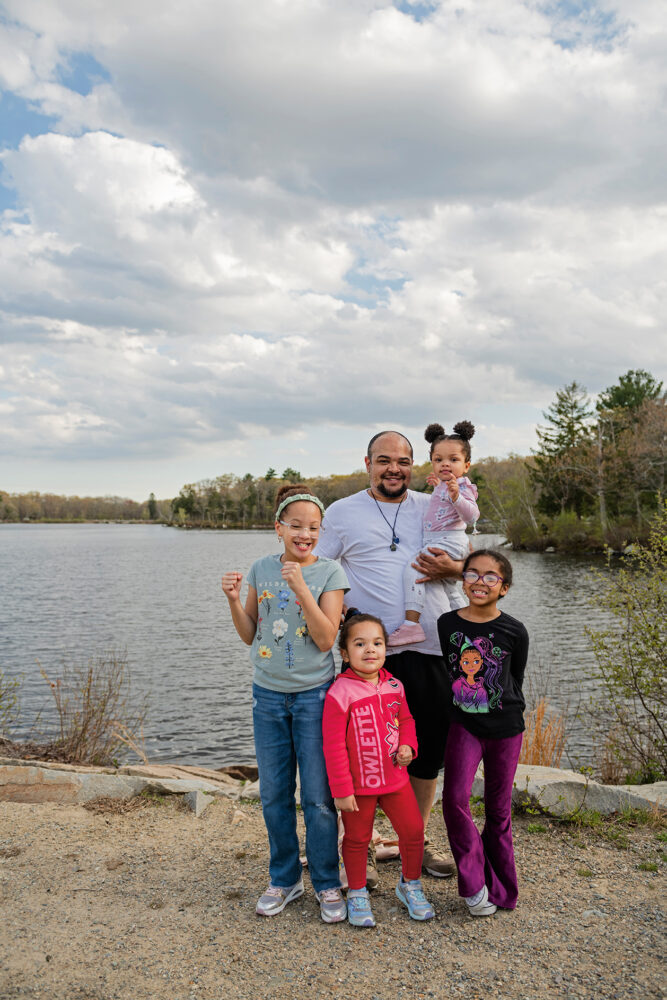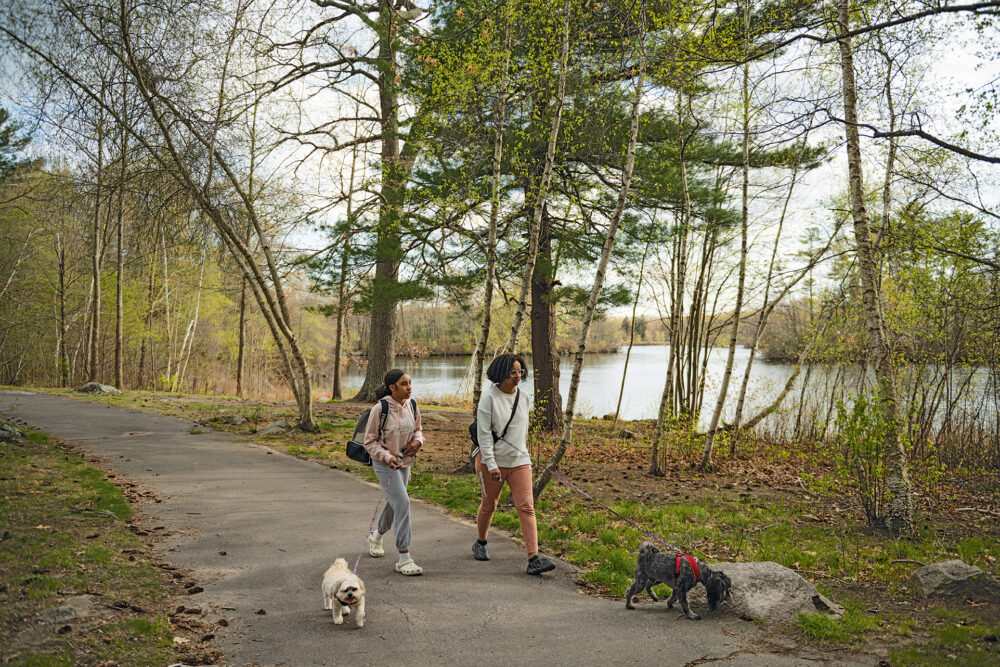Insufficient Funds
Supporting collaborative efforts key for environmental projects
By Annie Sherman| Photographs by Cate BrownDONORS AND GRANT MAKERS WANT TO SUPPORT “SHOVEL-READY PROJECTS.” BUT WHAT ABOUT THE PEOPLE WHO ARE KEY TO AN ENVIRONMENTAL PROJECT’S SUCCESS?
On a sunny spring day in Brockton, Massachusetts, D.W. Field Park is hopping with activity. Everyone from young families to retirees comes to spend an afternoon in the park’s 650 verdant acres. On the National and State Registers of Historic Places, it straddles Brockton and Avon and is a singular green oasis for the region’s 110,000 people. They are walking and biking its miles of paths, fishing its seven ponds and reservoirs, spotting flocks of birds flitting about its arboreal canopy, and otherwise simply enjoying its natural green space.
Ulisses Varela has enjoyed this park in this way since he was a kid. Now, with a growing family, he knows the park is the environmental nucleus of a city rich with immigrants, multi-family housing, and concrete that traps heat and funnels floodwaters in storms.
“D.W. Field was designed originally as passive recreation and for motorists, for that Sunday drive to admire nature. For walking, fishing, biking, reading, bird watching—those were the main aims of the park,” says Varela, a Brockton native, volunteer park commissioner, and head administrative assistant for Plymouth County Superior Court in Brockton. “But there is a growing appetite for updated uses of the park.”
Managed by the city’s Parks and Recreation Department, the historic park had fallen victim to municipal divestment. Flood erosion had undermined safety, the public complained of the park’s deteriorating roads and pathways, and overgrowth prevented access to the water. But to fix all of this, municipal staff needed to conduct extensive planning and licensing work before completing any repairs—a behemoth multi-year undertaking for a small municipal departmement.

A family enjoys an afternoon at D.W. Field Park in Brockton, Massachusetts.
“As we move forward, that’s going to be one of the biggest challenges—the original intended use, the growing needs of the community, and the ability of the Parks Department to be able to fulfill those needs and to maintain the park,” Varela says.
This is a common dilemma in environmental initiatives, especially within nonprofit organizations that rely on grant funding or understaffed city offices with strict budgets. Grant applications often stipulate that any initiative—from restoration or preservation of an existing space to a completely new infrastructure—be “shovel-ready.” This means funds support physical labor or construction exclusively and that all plans, municipal agreements, and zoning authorization must be in place.
But getting a project to the shovel-ready stage requires months, if not years, of collaborative effort. So, leaders in this field argue that the people involved behind the scenes warrant the funding because, without them, any project would not survive.
Leaders add that the method of funding should support people first. But since that’s not tangible, that’s not sexy, and that’s not a data-driven return on the funder’s investment, many say, the funds are often restricted to the actual physical project.
“When it comes to grant programs, there often are stumbling blocks … Some grant applications take weeks to actually put together. So, staff capacity can be a hindrance to going after money. A lot of grant programs require some sort of match commitment. So, it’s not just ‘apply for $50,000 and get $50,000.’ You have to come up with 25% of that before you can even apply for the remaining. So that’s often a big barrier,” says Joanne Zygmunt, senior planner with Old Colony Planning Council, who is working with Brockton, Avon, Wildlands Trust, and other partners on the park’s master plan and rejuvenation.
“That’s hard, also, because [organizations are] looking for money to do stuff, and if they had it, they’d be doing it,” she adds. “And there’s a bias often in funding programs for actual shovel-ready projects, the physical thing that you can see on the ground, that you can cut a ribbon for, that you can take pictures at. But in order to get to that point, there’s so much work that needs to happen. And it’s extremely difficult to find grants that will fund that portion.”
Small and startup nonprofits, or those that support marginalized communities, suffer further staff funding challenges. However, according to April Brown of the Racial and Environmental Justice Committee (REJC), funding staff is the only way they remain viable.
REJC was founded in 2017 to facilitate co-governance and to share decision-making between communities at the frontlines of environmental and racial injustices in Rhode Island and the institutions that hold decision-making power. This work comes in weeks- or months-long chunks of time, not years, she laments, because she has no endowment to encourage future growth plans, upon which larger nonprofits often depend. So, the former Pentecostal preacher says she can’t let herself dream too big or too far ahead.
“People call us the moving force in environmental justice, but we are vulnerable in many ways because we don’t have enough funding to complete projects. But we are the ones talking to legislators, talking to municipalities, putting forth praxes for municipalities to do what we do in community. We worked with the city of Providence to do a climate justice plan. We put together frameworks based on a just transition,” Brown says of REJC’s accomplishments amid the challenges.
She adds that the group could continue their efforts for another decade, “but no one has the capacity to do this work because we still have almost 100 years of lack of investment.”
D.W. Field Park improvements included staff capacity, not just infrastructure.
Groundwork Southcoast struggles with the same dilemmas. A member of the network of 21 organizations that work with communities to promote racial equity and improve environmental quality, Groundwork was established in 2017 with $300,000 in seed funding. By 2023, its budget had grown by 400% to reach $1 million, and its staff had grown by 300%. That progress has been hard fought, says founding and current executive director Maura Valdez.
Eighty percent of its funding is from federal, state, or municipal sources that require strict spending reports down to the penny, she says. However, because she lacks enough staff—which consists almost entirely of low-income residents with significant experience living in the environmental justice communities they serve—the organization struggles to establish relationships with wealthy private donors.
This limits their funding options. She adds that the organization cannot secure or manage funds successfully without including overhead costs. However, many grants allow for a maximum overhead of 10%, while Valdez’s true staffing costs are more like 40% of the grant.
“There’s a lot of funding focused on Justice40 communities from the federal government and a lot of other dollars that are theoretically flowing into work in environmental justice communities,” Valdez says, referring to President Joe Biden’s 2022 goal to devote 40% of certain federal investments to marginalized communities that are overburdened by pollution. “But those dollars are often hard to access … the grants are structured in a way that without significant capacity building components to it, you can’t just magically have the money and what they call a shovel-ready project, or significant environmental transformation or restoration projects ready to go.”

Blackstone Watershed Collaborative (BWC) program manager Stefanie Covino says her program was born after the Narragansett Bay Estuary Program (NBEP) spent two years embedded in the community connected to the Blackstone River—talking with citizens, businesses, universities, and nonprofits to learn what environmental issues were important, what those groups needed, and how NBEP could help.
The result was the Blackstone River Watershed Needs Assessment Report, released in 2021, which was a baseline status of the watershed, Covino says, and included 20 action items that various partners could tackle together to improve water quality and climate resilience within the region.
The report highlighted the need to create a collaborative to continue fostering dialogue, especially with under-capacity organizations and underrepresented voices. The NBEP launched the BWC, a consortium of 125 diverse organizations based at Clark University in Worcester, Massachusetts.
“I’ve found that grants will often say that they want to fund capacity because it’s becoming more popular, which is fantastic, and they’re starting to see the importance of people working together on these issues, cross collaboratively and from different perspectives,” Covino explains. “But a lot of times an application for capacity will be judged against other applications for implementation, and funders nearly always choose implementation.”
Indeed, because the Rhode Island Department of Environmental Management (DEM) recognized the high value of merging talent development and community representation, it hired a climate justice specialist to liaise between the state agency and the people it serves.
In that role, former Peace Corps volunteer Chris Gaynor bridges organizations and individuals with state resources—including advising them to incorporate justice and equity into policy and programs with the feedback he garners from impacted communities.

To do this, DEM utilizes a three-year Environmental Justice Government-to-Government grant from the Environmental Protection Agency to engage, educate, and empower seven community partners from Central Falls, Woonsocket, Providence, and Pawtucket of the harms perpetuated by unjust policies and equip them with tools, resources, and a network that would reduce the barriers of access to state resources, Gaynor explains.
He’s relying on the expertise of REJC to implement an environmental justice curriculum that informs future policy and to break the literacy gap surrounding grant writing. That leads to boots-on-the-ground efforts, he says, including community members participating in park maintenance to foster attachment and education, maybe even a career path, he hopes.
This parallels Valdez’s efforts in the South Coast region and is a common theme among industry leaders.
“When it comes to these environmental justice community-based organizations, in order to receive any form of funding, they really need grant writers, folks that are able to take the time and focus on it. The smaller groups don’t have a fundraising team or a communications team. They have Twitter, Instagram, and sometimes TikTok. That’s great, but even with that level of engagement and ability to interact with your audience, the question that comes up is, ‘Who is your funding audience?’” Gaynor says. “At times, it might be the same audience. But in my experience, the funding comes from very passionate environmentalists who want to see the preservation of large green spaces. And because of various biases, it’s not always targeted towards the green spaces that really need those funds. [Funding is] constantly being put into another specific space because its value is treasured by X funder or X entity. So, it biases the lens.”
Meanwhile, planning for D.W. Field Park improvements moves ahead with capacity funding from NBEP and a partnership with the land conservation and stewardship nonprofit Wildlands Trust, whose work on the park is supported by a private foundation. It successfully planned a public survey to engage members of the community on what they wanted the park to be and utilized that feedback to purchase land to expand park grounds; develop a park master plan to tackle erosion, water quality, and restoration; better manage parking and speeding; and create service-learning opportunities for local students. With these adjustments, many of which were funded by staff capacity grants, Varela and Zygmunt know D.W. Field Park will remain the green destination residents need.
“I recognize the value in parks, and I see how beneficial they are to a person’s life. Families are the nucleus and the foundation, and anything we can do to support that is a win. And D.W. Field is the gel that kind of connects that nucleus,” Varela says. “If we can introduce our children to some of these places, so they can experience what life is like—not just in the city, but in other green places—and learn, that’s what the park can offer as well.”
Narragansett Bay Estuary Program
This issue is supported by the Narragansett Bay Estuary Program (NBEP), a nonprofit organization led by stakeholders that pursues place-based conservation across the three-state Narragansett Bay region.
With its 30-member partnership, NBEP catalyzes scientific inquiry and collective action to restore and protect the region’s water quality, wildlife, and quality of life.
This issue of 41°N highlights several of the stories and partners driving a 10-year blueprint to realize their vision of clean water and habitat to sustain all who live, work, and play in the Narragansett Bay region.
Contact Us
Telephone: (401) 874-6805
Email: allard@uri.edu
Contributor Guidelines
Please review submission guidelines to be considered. d

